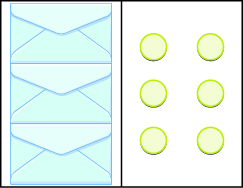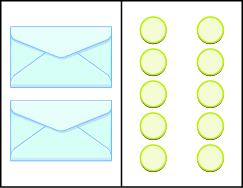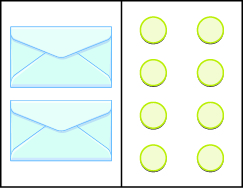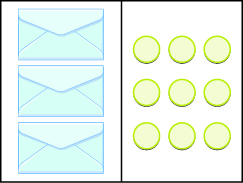Translate to an Equation and Solve
In the past several examples, we were given an equation containing a variable. In the next few examples, we’ll have to first translate word sentences into equations with variables and then we will solve the equations.
Example \(\PageIndex{7}\): translate
Translate and solve: five more than \(x\) is equal to \(−3\).
Solution
| Translate. |
x + 5 = −3 |
| Subtract 5 from both sides. |
x + 5 − 5 = −3 − 5 |
| Simplify. |
x = −8 |
Check the answer by substituting it into the original equation.
\[\begin{split} x + 5 & = -3 \\ -8 + 5 & \stackrel{?}{=} -3 \\ -3 & = -3 \; \checkmark \end{split} \nonumber \]
Exercise \(\PageIndex{13}\)
Translate and solve: Seven more than \(x\) is equal to \(−2\).
- Answer
-
\(x+7=-2\); \(x=-9\)
Exercise \(\PageIndex{14}\)
Translate and solve: Eleven more than \(y\) is equal to \(2\).
- Answer
-
\(y+11=2\); \(y=-9\)
Example \(\PageIndex{8}\): translate
Translate and solve: the difference of \(n\) and \(6\) is \(−10\).
Solution
| Translate. |
n − 6 = −10 |
| Add 6 to each side. |
n − 6 + 6 = −10 + 6 |
| Simplify. |
n = −4 |
Check the answer by substituting it into the original equation.
\[\begin{split} n - 6 & = -10 \\ -4 - 6 & \stackrel{?}{=} -10 \\ -10 & = -10 \; \checkmark \end{split} \nonumber \]
Exercise \(\PageIndex{15}\)
Translate and solve: The difference of \(p\) and \(2\) is \(−4\).
- Answer
-
\(p-2=-4\); \(p=-2\)
Exercise \(\PageIndex{16}\)
Translate and solve: The difference of \(q\) and \(7\) is \(−3\).
- Answer
-
\(q-7=-3\); \(q=4\)
Example \(\PageIndex{9}\): translate
Translate and solve: the number \(108\) is the product of \(−9\) and \(y\).
Solution
| Translate. |
108 = −9y |
| Divide by −9. |
$$\dfrac{108}{-9} = \dfrac{-9y}{-9}$$ |
| Simplify. |
−12 = y |
Check the answer by substituting it into the original equation.
\[\begin{split} 108 & = -9y \\ 108 & \stackrel{?}{=}-9(-12) \\ 108 & = 108 \; \checkmark \end{split} \nonumber \]
Exercise \(\PageIndex{17}\)
Translate and solve: The number \(132\) is the product of \(−12\) and \(y\).
- Answer
-
\(132=-12y\); \(y=-11\)
Exercise \(\PageIndex{18}\)
Translate and solve: The number \(117\) is the product of \(−13\) and \(z\).
- Answer
-
\(117=-13z\); \(z=-9\)
Practice Makes Perfect
Determine Whether a Number is a Solution of an Equation
In the following exercises, determine whether each number is a solution of the given equation.
- 4x − 2 = 6
- x = −2
- x = −1
- x = 2
- 4y − 10 = −14
- y = −6
- y = −1
- y = 1
- 9a + 27 = −63
- a = 6
- a = −6
- a = −10
- 7c + 42 = −56
- c = 2
- c = −2
- c = −14
Solve Equations Using the Addition and Subtraction Properties of Equality
In the following exercises, solve for the unknown.
- n + 12 = 5
- m + 16 = 2
- p + 9 = −8
- q + 5 = −6
- u − 3 = −7
- v − 7 = −8
- h − 10 = −4
- k − 9 = −5
- x + (−2) = −18
- y + (−3) = −10
- r − (−5) = −9
- s − (−2) = −11
Solve Equations Using the Division Property of Equality
In the following exercises, solve each equation using the division property of equality and check the solution.
- 5x = 45
- 4p = 64
- −7c = 56
- −9x = 54
- −14p = −42
- −8m = −40
- −120 = 10q
- −75 = 15y
- 24x = 480
- 18n = 540
- −3z = 0
- 4u = 0
Translate to an Equation and Solve
In the following exercises, translate and solve.
- Four more than n is equal to 1.
- Nine more than m is equal to 5.
- The sum of eight and p is −3.
- The sum of two and q is −7.
- The difference of a and three is −14.
- The difference of b and 5 is −2.
- The number −42 is the product of −7 and x.
- The number −54 is the product of −9 and y.
- The product of f and −15 is 75.
- The product of g and −18 is 36.
- −6 plus c is equal to 4.
- −2 plus d is equal to 1.
- Nine less than n is −4.
- Thirteen less than n is −10 .
Mixed Practice
In the following exercises, solve.
- (a) x + 2 = 10 (b) 2x = 10
- (a) y + 6 = 12 (b) 6y = 12
- (a) −3p = 27 (b) p − 3 = 27
- (a) −2q = 34 (b) q − 2 = 34
- a − 4 = 16
- b − 1 = 11
- −8m = −56
- −6n = −48
- −39 = u + 13
- −100 = v + 25
- 11r = −99
- 15s = −300
- 100 = 20d
- 250 = 25n
- −49 = x − 7
- 64 = y − 4
Self Check
(a) After completing the exercises, use this checklist to evaluate your mastery of the objectives of this section.
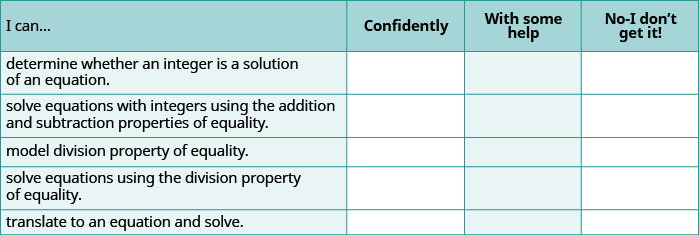
(b) Overall, after looking at the checklist, do you think you are well-prepared for the next Chapter? Why or why not?



